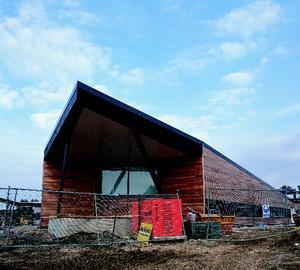One of the real problems lies in defining sustainability: a word long on promise but short on precise meaning. Following the Rio Earth Summit in 1992, the focus of sustainable building design has gradually broadened from the specific issue of how materials are exploited, to the broader objective of how buildings are conceived, built and used.
In early 1997 Essex County Council teamed up with the Design Council to run a design competition for a primary school on a greenfield site. The joint initiative arose from a shared interest in understanding better teamworking and how to use a design team to produce a sustainable building. The Design Council had been looking for a complex building design problem it could study from inception to expose the dynamics of a team at work.
The competition attracted 91 entrants, which were whittled down to six for interviewing by a judges panel led by architect Will Alsop and the client. The job was eventually won by architect Allford Hall Monaghan Morris and environmental engineer Atelier Ten.
The County Council's brief was to construct a 180-place sustainable primary school at the new garden village of Great Notley, where 2000 homes are being built. The budget for the project was £1.2 million. Rather than dictate specific issues of sustainability, the client asked the design team to explore ideas which could be adapted for other projects.
The team's strategy was to devise a compact building form which would reduce the need for internal circulation while minimising the ratio of floor area to external wall area.
The result looks somewhat unconventional. The school is triangular, its single-storey sitting on the north-eastern edge of a delta-shaped site. It is orientated to maximise solar gain with the six main classrooms and external teaching spaces facing south-east. Thermal modelling studies showed facing south-west would create little difference in effect.
Construction details
The internal walls are load-bearing masonry which support a timber roof structure. The floors are precast concrete panels topped with insulation and screed, and sit on strip foundations. The timber frame, external breathing walls are clad in untreated cedar boarding and constructed from timber studs, with cellulose insulation and recycled wood fibre sheathing. This type of wall has a higher vapour permeability than conventional timber frames and allows moisture migration to the outside. The roof is an Erisco Bauder sedum-planted system where pre-planted mats are laid onto the vapour barrier and insulation.
The ceilings are finished in birch-faced plywood fixed directly to the roof. A plasterboard suspended ceiling conceals the mechanical and electrical services distribution.
An initial audit of materials was carried out using selection criteria of low embodied energy, renewable resources and recycling – in terms of materials made from recycled products and the capability for recycling.
Linoleum has been used in some teaching and administration areas as well as corridors, toilets and cloakrooms. Compressed bamboo boards cover the hall floor, while compressed plastics bottles have been used for work surfaces and recycled tyres for entrance mats.
The school hall is in the apex, flanked by the kitchen and servery on one side and store and plantroom on the other. The offices are on the eastern side of the building, while the staff room, food and computer technology classrooms are on the western side.
Forming the heart of the school is an internal court which acts as an extra teaching space, overspill space from the hall and a circulation hub, linking the hall to the classrooms. The courtyard originally started life as an external space, forming part of the natural ventilation strategy. However, many such spaces are eventually covered over in the hunt for extra usable internal space, thus ruining the design concept. Here, the designers pre-empted the move.
The courtyard is reflected by a triangular, external space under the nose-cone of the building on the opposite side of the hall. In addition to finishing the building, this provides external teaching space. It is designed to give the school flexibility of use, such as for assemblies or school plays, when more seating space would be needed.
As well as careful choice of resources, the concept of sustainability means using resources effectively. Using Notley Green purely as a primary school would account for only about 14% of year. While 24 h use may be hard to achieve, it should be possible to increase the figure significantly. To achieve this, the building has been specifically designed for use out of school hours. The layout lets the public use the hall and internal court without being able to gain access to the main building.
While the design team tried to specify home-grown products, some materials had to be sourced from abroad – a problem that will remain until the UK market for sustainable products improves.
Environmental engineering
As might be expected, the school is largely naturally ventilated. Cross-ventilation is exploited by using a mixture of high and low level windows in the classrooms and hall.
The statutory minimum rate of 3 litres/s/pupil has been used as the basis for establishing minimum openings. During the winter, background ventilation will be achieved by trickle ventilators. In warmer weather, openable windows can be used.
The main hall is ventilated from low to high level between the north facing glazed facade and high level strip rooflight which can be opened using manually operated winding gear. Similarly in the classrooms, fresh air enters through low level windows and is exhausted through manually-wound rooflights.
Rooflights to internal spaces such as the internal court and medical room include ventilation in the perimeter upstand to ensure minimum airflow. The library spaces adjacent to the internal court are ventilated via earth ducts running from a louvred plenum on each side of the building to displacement units.
The openable rooflights in these areas are controlled by motorised opening gear linked to temperature sensors. The rooflights and motorised opposed blade dampers which control the amount of fresh air from the earth ducts are both proportionally controlled to ensure an even distribution of temperature and air flow. Although the corridor linking the classroom to the internal court is relatively long, the environmental engineers believe that regular opening of doors, supplemented by rooflights outside the classrooms, will be sufficient for natural ventilation.
Mechanical plant
What little mechanical ventilation there is resides in the toilets and kitchen. In the toilets 5-6 ac/h is provided by a Willan Passivent stack ventilation system. In the kitchen, extract plant is placed at high level in the form of a two-speed upblast fan. Heat recovery was rejected as the coils would become encased in grease and other deposits, presenting an unnecessary maintenance headache.
Gas was selected as the main fuel source for the building on the basis of cost and cleanliness. Although the DfEE's Building Bulletin 87 suggests the use of dual-fuel boilers, this was not followed as no suitable, high efficiency condensing boiler which can run on either oil or gas is currently available. There was also no infrastructure for an alternative fuel supply, and using oil would lead to increased maintenance costs.
The compromise involved using two 60 kW condensing boilers, which have high seasonal efficiency. The 65 kW load is shared by both boilers, although a single boiler can handle the base load should one fail.
Condensing boilers work best with underfloor heating systems, and at Notley a Pipe2000 system was used. It comprises continuous lengths of polyethylene pipe buried in the floor screed and fed from zone manifolds located around the building. Each zone on the system has an adjustable thermostat with a setpoint of 21°C±2°C. Three manifolds serve the 22 control zones in the building.
The advantages of such a system are that with a surface temperature of 21-26°C and radiant heat from the floor, it is most comfortable for the activities of young children. It creates low velocity air convection and distributes heat evenly across the entire floor, the zone with most activity. Underfloor heating also frees up wall and floor space from radiators which may be a danger to children.
Lighting
Using a combination of perimeter windows and clerestory lights, the aim was to provide an average daylight factor of 4-5% consistently throughout each classroom. The rooflights take natural light into the back of the classrooms as well as other spaces.
The hall is also lit naturally, using a rooflight that runs across its width. An obscured glass panel above the external doors allows further natural light into the area. Direct solar gain and glare is controlled at the perimeter by brise-soleil. The natural lighting is complemented by artificial lighting provided by low energy, compact fluorescent lamps in flush ceiling mounted luminaires. All lighting in the building is manually controlled.
Other technologies
The design team explored the use of archetypal, leading-edge 'sustainable' features but found them to be inappropriate. For example, three photovoltaic options were studied based on 10, 35 and 70 m2 pv arrays. However, the payback for each was calculated at over 200 years and considerable areas of pv panels would be needed to make a real difference to the operating performance of the building. While a computer could be run from 2 m2 of pvs, the system could generate this only for 1-2 h/day in winter and 4-5 h/day in summer.
For effective use of biomass in space and water heating a nearby source of fuel would be required to reduce the environmental impact of transport. There is no such source near Great Notley, although there is potential for growing and harvesting willow on the site. The main drawback is the intensity of maintenance. The cost of employing someone to stoke the boiler daily would be disproportionate to the energy saved.
Solar power for heating and water would be efficient during July and August, just when the demand would be very low. The use of flat plate collectors and evacuated tube collectors was explored, however, again the payback period was prohibitive at 30 years.
Wind turbines were also considered. Apart from cost, the appearance and noise generated makes them difficult to use near housing. A turbine sized to meet the winter consumption over 24 h would need a rated output of 21·5 kW. This would contribute 70% to the annual demand for the school which is likely to be 33-34 000 kWh. However, the size of the plant – a 25 m high mast, 10 m diameter rotor, and associated battery bank with control house – would have significant planning implications and cost around £60 000.
The technologies used in the school may not be startling, but that would be to miss the point. For the client, it was important to have ideas that can be used elsewhere within the constraints of a typical budget. The Design Council has monitored the design team throughout and will use the data to publish a model of the process which can be used to educate architects and designers.
Building Services Journal intends to follow and report on the school's manageability and energy performance in a future issue.
Notley Green Primary School, Great Notley, Essex
Tender date: July 1998
Form of contract: JCT 80 (local authority version) Was National Engineering
Specification used: No U-Values (W/m2k)
Walls: 0·21
Roof: 0·32
Glazing: 1·60 (low-E glass)
Floors: Timber finish: 0·38
Carpet/lino finish: 0·37 Internal design conditions
Classrooms: 18°C
Offices: 20°C
Assembly halls: 18°C
Summer: 28°C, 60% rh (not critical)
Circulation & toilets: 18°C±2°C External design conditions
Winter: -4°C/Sat
Summer (non a/c): 29°C db, 19°C wb Noise levels
Offices: NR 35-40
Toilet & circulation: NR 40 Target energy use (gfa)
Gas: 65 kWh/m2/y
Electricity: 126·2 kWh/m2/y
CO2 target: 21·39 kg/m2/y
Energy breakdown
Heating: 142 kWh/m2/y
Fans & pumps: 3·0 kWh/m/y
Lighting: 16·56 kWh/m2/y
Typical occupied hours: 08.00 h – 15.30 h
Diversity: 38 weeks
Allowable heat loss: 3 kW/K
Actual heat loss: 3 kW/K
Fabric leakage: Not provided
BREEAM: No Loads
Calculated heating load: 69 kW
Installed heating load: 120 kW
Fan power: Data not available
Occupancy: 26 W/m2
Solar gain (winter): 25 W/m3
Solar gain (summer): 35 W/m3 Lighting
Types: CFL, HF fluorescent
Lux levels
Office: 500
Kitchen: 300
Computer: 300
Toilets: 100-150
Circulation areas: 100-150
Glare index: 19 Distribution circuits
LTHW: 82°C flow, 71°C return
Underfloor heating: 55°C flow, 45°C return Electrical supply
130 kVA Costs
Total cost: £1 226 536
Building services total: £266 934
Net cost £/m2: 1174.84
Building services £/m2: 255.68 Mech services cost £/m2 (gfa)
Sanitary appliances: 14.78
Cold water services: 14.04
Hot water services: 28.30
Heating services: 34.65
Ventilation: 14.04
Drainage: 33.73
Thermal insulation: 15.48 Electrical services £/m2
Meters & switchgear: 8.69
Lighting installation: 46.87
Power installation: 15.84
Controls package: 13.68
Fire alarms & detection: 7.12
Security: 3.23
Telephone & data: 1.13
Earthing & bonding: 0.70
Sundries: 0.52
Preliminaries: 2.87
Source
Building Sustainable Design
Postscript
Alastair Blyth MA Dip Arch RIBA is an architect specialising in briefing, and is monitoring the Notley School project for the Design Council.
Credits
Client Essex County Council Architect Allford Hall Monaghan Morris M&E consulting engineer Atelier Ten Structural & civil engineer Atelier One Quantity surveyor The Cook and Butler Partnership Landscape architect Watkins Dally Main contractor Jackson Building Mechanical contractor Essex Mechanical Services Electrical contractor Ruddocks Ltd






















